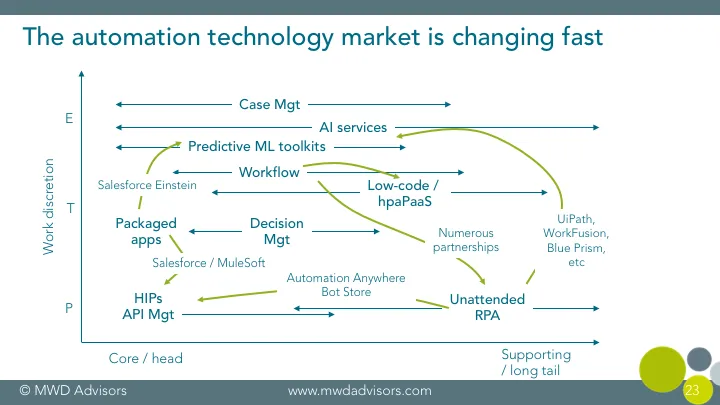Mapping out an emerging architecture for automation
|
|
A whole heap of technologies are vying to play roles in enterprises’ automation strategies. This is a fast-moving space.
Next week I’ll be keynoting at the annual bpmNEXT conference held in Santa Barbara. Most of the attendees at past events have been technology vendors in the business automation space, and this year (as in past years) a portion of my talk will be directly addressed to them.
This year, my talk’s called “A new architecture for automation” and the message I have for any automation technology vendor (whether specialised in BPM/workflow, low-code app development, decision management, RPA, or something else) in the room is this: you need to work harder on making your platforms open and componentised as well as being easier to use; and when thinking about how your product(s) deliver value customers in combination with others, don’t just think about the runtime-operational side of automation. Also think about managing automations through their lifecycle – not least reporting, analytics, management, and governance.
A new architecture for automation in today’s and tomorrow’s businesses is emerging quickly; but the speed with which the component technologies are changing means that few organisations will want to go all-in and place all their investment with a single end-to-end platform. Vendors will need to play together.
Automation strategies need to encompass multiple different types of work in multiple parts of businesses if they’re to have real impact. They will in most cases require the integration of multiple runtimes; but more than that, sustainable automation initiatives will require end-to-end operational insight and management. Some vendors will be in a better position to do that than others.
One of the slides I have provides a thumbnail sketch of some of the recent market moves we’ve seen in the automation space – see below. (It’s not meant to be exhaustive!)

The vertical access ranges across three different types of ‘knowledge’ work that are potential targets for automation: (E)xploratory, (T)ransactional and (P)rogrammatic. The horizontal axis ranges between work that’s centralised in the core processes of a business, where the main concentration of core value activity is; and work that’s dispersed more across a ‘long tail’ of supporting processes, across a range of diverse situations.
As you can see, looking at how I’ve clustered technology vendors, there are few clusters that are isolated. Most are shifting and converging – partnering or colliding. This is a fast-moving space and we all need to watch closely.
I’ll be sure to share my slides after bpmNEXT, for anyone who’s interested, and I’ll also be writing commentary on the other talks and sessions I see at the event.
The post Mapping out an emerging architecture for automation appeared first on MWD Advisors.